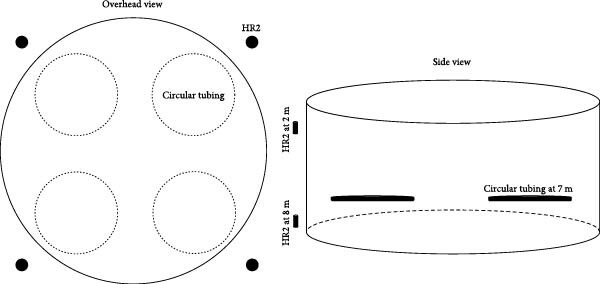
Climate change is causing significant alterations in marine environments, including rising temperatures and increasing low oxygen events. These changes pose serious threats to the health and well-being of farmed fish species, such as Atlantic salmon.
Oxygen supplementation systems have emerged as a potential mitigation strategy to counteract the harmful effects of low oxygen conditions.
A study led by scientists from Dalhousie University (Canada) utilized high-resolution acoustic tags to track the movements of Atlantic salmon in a commercial farm equipped with an oxygen supplementation system. The goal was to investigate how oxygenation affected fish behavior during and after the trial.
Dissolved Oxygen and Fish Health
Dissolved oxygen (DO) is a critical factor for the growth and health of farmed fish, particularly Atlantic salmon (Salmo salar). For example, when water temperatures hover around 15°C and DO levels drop below 6.0 mg/L, Atlantic salmon begin to experience a reduction in appetite. If DO levels fall below 4.0 mg/L, the fish switch to anaerobic metabolism to conserve oxygen, which can significantly impact their overall health and growth.
The response of salmon to low DO levels depends on both the duration and frequency of exposure. Short-term exposure to low oxygen levels can cause physiological stress, manifested as decreased swimming speed and reduced appetite. Prolonged exposure to hypoxic conditions, particularly at levels below 6.0 mg/L, can lead to energy conservation behaviors such as slower swimming speeds and reduced food intake, ultimately resulting in increased mortality rates. While salmon can avoid hypoxic conditions by migrating vertically within the net pens, other factors such as fish density and water temperature can complicate their ability to escape unfavorable environments.
Mitigating Low Oxygen Levels: Oxygen Supplementation in Aquaculture
With the growing demand for Atlantic salmon and the expansion of aquaculture sites, including larger cages and higher stocking densities, maintaining optimal DO levels has become a priority. As cage sizes increase, the surface-to-volume ratio decreases, reducing water exchange within the net pens and exacerbating oxygen depletion. To address this, many farms have begun using oxygen supplementation systems to maintain adequate DO levels.
One method of oxygen supplementation involves the use of hose-based diffusers to pump oxygen gas nanobubbles into the net pens. Another approach involves oxygenating the water within a barge-based system and then reintroducing the oxygenated water into the net pen. Despite the innovation behind these technologies, their effects on fish behavior and well-being are not yet fully understood.
Understanding the Impact of Oxygen Supplementation on Salmon Behavior
In previous studies, researchers used acoustic tags to collect high-frequency data on salmon positioning within sea cages, providing valuable insights into fish behavior under different environmental conditions. The current study aimed to investigate the effects of oxygen supplementation on Atlantic salmon behavior at a commercial aquaculture site in Nova Scotia, Canada.
Stay Always Informed
Join our communities to instantly receive the most important news, reports, and analysis from the aquaculture industry.
The Study
This study employed high-resolution, high-frequency acoustic tags to track the movements of Atlantic salmon on a commercial farm. Fifteen fish were equipped with tags, allowing precise tracking of their position and behavior at three-second intervals. The study period spanned two months, covering both the oxygen supplementation trial and a subsequent control period.
Key Findings
Analysis of fish movement data revealed several notable changes during the oxygen supplementation trial:
- Reduced swimming speed: All tagged individuals exhibited slower swimming speeds during the trial compared to the control period.
- Increased proximity to the cage edge: Seventy-seven percent of tagged fish swam closer to the cage perimeter during the trial.
- Straighter swimming patterns: Eighty-five percent of the fish exhibited less erratic swimming behavior during the trial.
- Lower swimming depths: Eighty-five percent of the tagged population swam at lower depths during the trial.
Implications for the Salmon Industry
While this study provides valuable insights into the potential effects of oxygen supplementation on Atlantic salmon behavior, it is important to note that definitive causality cannot be established due to the influence of other environmental factors.
However, the findings suggest that increased technology on farms, such as high-resolution acoustic tagging, can offer valuable data to inform future research and improve our understanding of how oxygenation systems affect fish well-being.
Conclusion
This study demonstrates the potential of high-resolution acoustic tagging to provide valuable insights into the behavioral responses of Atlantic salmon to oxygen supplementation. The findings suggest that oxygenation may influence fish movement patterns, potentially reducing stress and improving overall well-being.
Further research is needed to establish a definitive causal link and explore the long-term implications of oxygen supplementation on fish health and productivity.
Contact
Caitlin L. Stockwell
Department of Oceanography, Dalhousie University
Halifax, NS, B3H 4R2, Canada
Email: cstockwell@usgs.gov
Reference (open access)
Stockwell, C. L., Filgueira, R., & Grant, J. (2024). The Effects of Oxygen Supplementation Infrastructure on Farmed Atlantic Salmon (Salmo salar) Behavior Using Acoustic Telemetry. Aquaculture Research, 2024(1), 6972744. https://doi.org/10.1155/2024/6972744
Editor at the digital magazine AquaHoy. He holds a degree in Aquaculture Biology from the National University of Santa (UNS) and a Master’s degree in Science and Innovation Management from the Polytechnic University of Valencia, with postgraduate diplomas in Business Innovation and Innovation Management. He possesses extensive experience in the aquaculture and fisheries sector, having led the Fisheries Innovation Unit of the National Program for Innovation in Fisheries and Aquaculture (PNIPA). He has served as a senior consultant in technology watch, an innovation project formulator and advisor, and a lecturer at UNS. He is a member of the Peruvian College of Biologists and was recognized by the World Aquaculture Society (WAS) in 2016 for his contribution to aquaculture.




